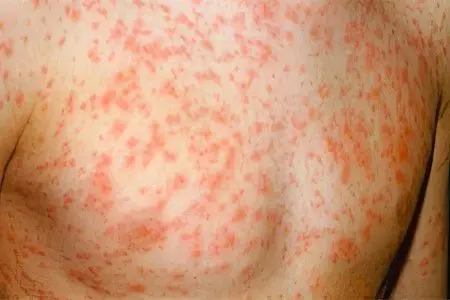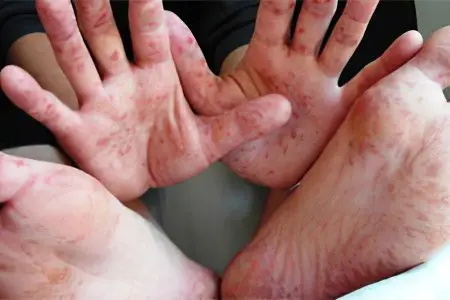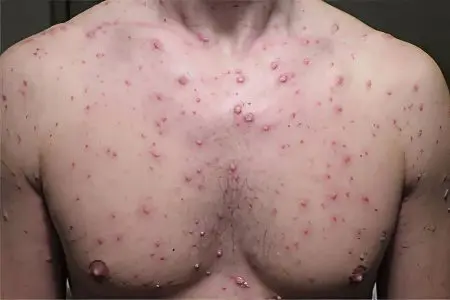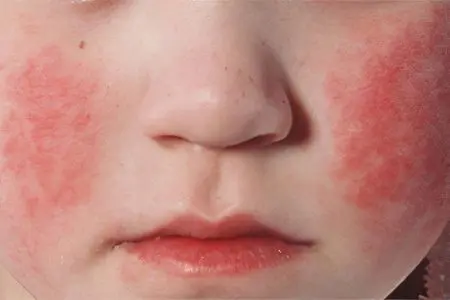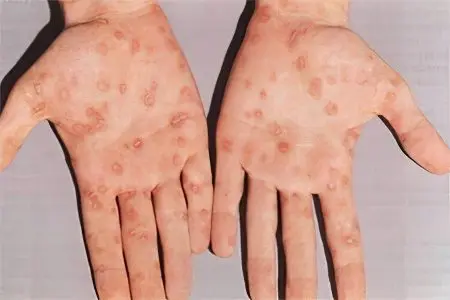Contents
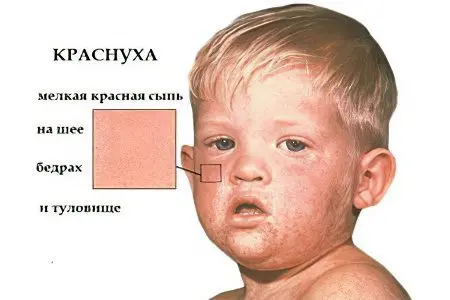
Rubella is a viral infection that most often affects children 1-7 years old. The name of the disease was due to the fact that spots of bright red color appear on the human body. Other names for rubella: third disease, rubella, german measles, measles rubella. Despite such a variety of terms, they all mean the same infection.
Rubella in adults, unlike children, is quite rare, but, like most “children’s” infections, it is more severe and often causes serious complications.
The disease got its name because of the main symptom of the disease – rubella rash. The source of infection in adults, as well as in children, is considered to be an infected person, especially in the last two days of the incubation period and for another five days after the onset of rashes.
The route of transmission of the disease is airborne. Rubella is a highly contagious infection, so the patient must be isolated, he is advised to comply with bed rest. If the pathology proceeds without complications, the necessary therapy is carried out at home.
Rubella symptoms
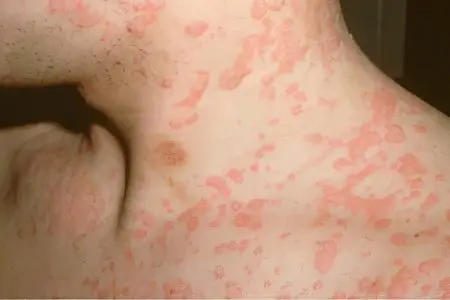
The incubation period for rubella lasts from 10 days to three weeks. The disease can be asymptomatic, manifesting itself on the fifth day – only after the appearance of rashes. After two days, fever may be observed with a rise in temperature to subfebrile values. In some cases, deterioration of health, headache, runny nose, loss of appetite may occur two days before the onset of rashes.
It is not difficult for a doctor to make a correct diagnosis. It is enough for him to see a rash on his body to understand what kind of infection provoked it. If doubts remain, the doctor will refer the patient for testing. This will confirm the diagnosis. The patient will need to donate blood, which will be sent for ELISA.
The most characteristic symptom of rubella in adults – a rash – is usually more pronounced than in children, individual elements of the rash can merge with each other, forming larger erythematous spots.
Small pink spots first appear behind the ears and on the nose, after which they spread to the arms and torso, moving over time to the lower limbs. When draining, the color of the spots becomes darker, which lasts 1,5 weeks. At the same time, adults have a general malaise, body temperature rises, patients are worried about headache, pain in the joints and muscles. In most cases, the disease is accompanied by profuse runny nose and sore throat.
In addition to the appearance of a rash, a person’s lymph nodes increase in size. This is due to the accumulation of a large number of viruses in them. The nodes located on the back of the head swell especially intensively. This symptom helps confirm the diagnosis.
From the moment of infection to the moment the first symptoms appear, about 10-25 days pass. A person will begin to spread the infection 1 day before the first elements of the rash appear. It remains contagious for up to 7 days after its onset.
The consequences of rubella during pregnancy
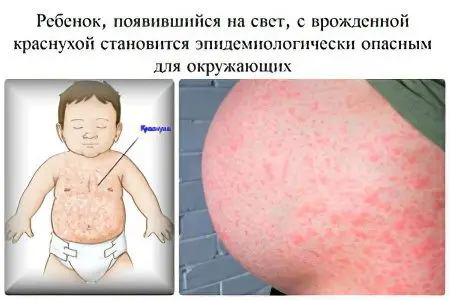
Of even greater concern are the symptoms of rubella in pregnant women. If the infectious process begins in the first trimester, then the doctor advises the woman to have an abortion, since intrauterine infection of the fetus often causes serious complications that cannot be treated. Among the consequences of a disease suffered by a child in the womb of the mother, malformations of the brain, heart disease and a violation of the formation of some internal organs can be observed.
In the event that an abortion is contraindicated for a pregnant woman, and in case of rubella infection in the later stages, the patient is given immunoglobulin, after which the condition of the mother and fetus is continuously monitored.
Babies under one year of age are rarely affected by the infection, as they receive protection from their mother. In addition, the contacts of babies with strangers are quite limited. If the infection still occurs, then the child suffers the disease severely. He has a high body temperature, develops vomiting and diarrhea. Self-treatment of a child with rubella is unacceptable. Be sure to call the doctor at home.
Rubella rash
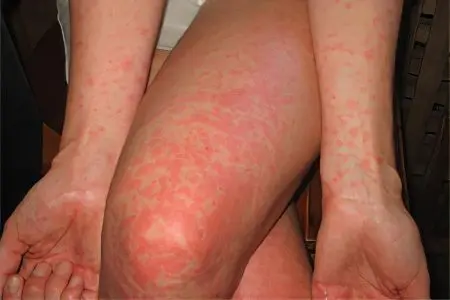
There are many diseases that are accompanied by the appearance of a rash on the body. Therefore, you need to know what features the rashes characteristic of rubella have.
A rash appears about 14 days after infection occurs. It remains on the skin for about 5 days. The exact timing depends on the individual characteristics of the human immune system. If the defenses are fully activated, the rash may disappear in 2-3 days.
Distinctive characteristics of the rash with rubella:
The rash first appears in the mouth. It looks like pink spots.
Then rashes appear behind the ears, on the cheeks, near the lips, near the nose.
A few hours later, the rash spreads throughout the body. It captures the buttocks, shoulders, elbows, hips and knees.
On the body, the rash will have a more saturated color than on the face.
Sometimes there is no rash on the face at all, it appears only on the body.
Spot sizes are kept within 5 mm. At first, the spots will be flat, and then begin to rise above the surface of the skin.
The elements of the rash are single, they do not merge with each other.
If you press on the spot, and then remove your finger, the rash will disappear, after which it will appear again.
Rubella rashes do not affect the skin of the palms, feet, and groin.
The spots may itch, although some patients are not bothered by them.
When the rash passes, there are no traces of its presence on the skin.
Sometimes rubella is asymptomatic. In this case, the rash does not appear on the body. It will be possible to make a correct diagnosis only thanks to a blood test.
How to distinguish a rubella rash from a rash of other diseases?
There are many diseases that are accompanied by the appearance of a rash on the skin.
However, there are some distinctive features of the lesion of the dermis, which you need to focus on:
Rubella | It focuses on the elbows, knees, face, shoulders and buttocks. The rash has a pale pink hue. |
Measles
| It covers the feet, face and upper body. The rash is bright, has a rich red color, looks like tubercles. |
Chickenpox
| It is located on the scalp, distributed throughout the body. The rash looks like spots that transform into bubbles and are filled with fluid. |
Scarlet fever
| Rashes appear on the body in the area of the folds, on the face in the area of the nasolabial triangle. The elements of the rash themselves are small and bright. The patient’s tongue acquires a crimson color. |
Mononucleosis
| Elements of the rash appear on the face, but they also appear on the torso. Sometimes the disease proceeds without a rash at all. |
Most often, rubella is confused with measles. While scarlet fever with these diseases is easier to differentiate, since not only the skin, but also the tonsils suffer.
With rubella, the rash spreads quickly over the body. It can occupy the entire surface of the body in a few hours. With measles, this process is extended for 2-3 days. The measles rash tends to coalesce. This does not happen with rubella. The rash passes quickly and leaves no traces behind. The root elements first become pale, peel off, and dark areas may remain in their place.
With roseola, the rash looks like papules, that is, tubercles that rise above the skin. In addition, the body temperature rises greatly. There are no catarrhal phenomena.
In any case, the appearance of a rash on the skin is a reason to consult a doctor. Only a doctor can make a correct diagnosis and prescribe treatment.
Rubella treatment
Treatment of rubella in adults is mandatory under the supervision of a specialist: you can not delay therapy and postpone the visit to the doctor. Serious consequences threaten patients in the absence of timely medical care.
Vaccination is considered the most effective preventive measure for people who did not tolerate rubella in childhood.










